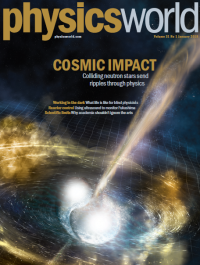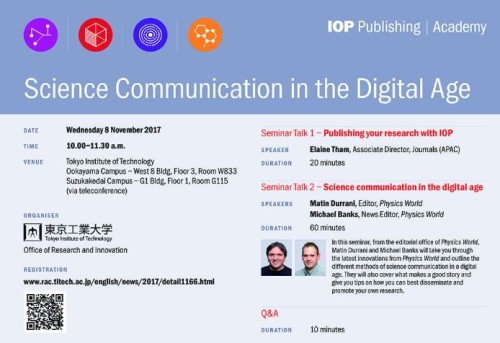Posts by: Matin Durrani
12 things we learned about the National Physical Laboratory

Hands-on physics – Sarah Tesh with a replica of the device used to measure temperature at the National Physical Laboratory
By Matin Durrani and Sarah Tesh
Here at Physics World we’re planning to publish special issues later this year on time (in July) and on SI units and measurement (in November). So to find out more about the latest work in these fields, we decided to accept a long-standing invitation to visit the National Physical Laboratory in Teddington, just outside London, yesterday.
The NPL is the UK’s national measurement laboratory and, as we found out on our visit yesterday, it’s home to almost 900 staff. Or, to be precise, there are 879 staff – after all, accuracy is the name of the game for the NPL, which provides vital measurement services to industry and plays a key part in global attempts to revise the SI measurement system.
It was a busy day for us and we came away with some useful ideas for possible articles for those two Physics World special issues. But rather than giving you a detailed run-down of everything we saw, here instead are 12 “fun” facts we picked up during our visit. Sometimes it’s those little details that make lab visits so intriguing.
View all posts by this author | View this author's profile
The February 2018 issue of Physics World magazine is now out
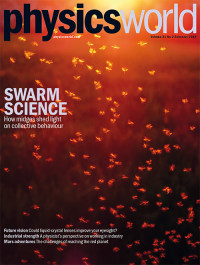 By Matin Durrani
By Matin Durrani
You’ll be delighted to know that the February 2018 issue of Physics World is now out in print and digital format.
In our cover feature this month, science writer Jennifer Ouellette discovers how tiny midges can shed light on collective behaviour in physics. You can also discover from Helen Gleeson how physicists are seeking to create liquid-crystal contact lenses – and learn from Stephen Ornes more about the technological challenges of going to Mars.
Don’t miss either our interview with the physicist who heads Japan’s leading funding agency and find out from astrophysicist Elizabeth Tasker about her experiences as an overseas scientist in the country.
And our veteran North America correspondent Peter Gwynne assesses the impact that Donald Trump has had on US science, one year into his presidency.
Remember that if you’re a member of the Institute of Physics, you can read the whole of Physics World magazine every month via our digital apps for iOS, Android and Web browsers.
Let us know what you think about the issue on Twitter, Facebook or by e-mailing us at pwld@iop.org
View all posts by this author | View this author's profile
See in the new year with the January 2018 issue of Physics World
Happy new year and welcome back to Physics World after our winter break. Why not get 2018 off to a great start with the January 2018 issue of Physics World, which is now out in print and digital format.
In our fantastic cover feature this month, Imre Bartos from Columbia University in New York examines the massive impact on physics that last year’s spectacular observation of colliding neutron stars will have.
Elsewhere, Bruce Drinkwater from the University of Bristol explains how he is using ultrasonics to monitor the damaged Fukushima nuclear-power plant in Japan, while science writer Jon Cartwright looks at how technology can help blind physicists.
Don’t miss either our interview with Fermilab boss Nigel Lockyer and do check out our tips for how to brush up your CV if you’re chasing a job in industry.
View all posts by this author | View this author's profile
It’s a cracker – the December 2017 issue of Physics World is now out
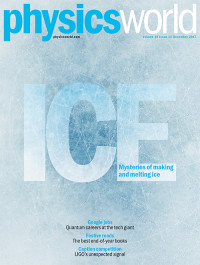 By Matin Durrani
By Matin Durrani
The December 2017 issue of Physics World, which is now out in print and digital format, has some great treats for you.
We’ve got two ice-related features – one by Jennifer Ouellette on a new “inverse” Mpemba effect, which suggests that cold water could warm faster than hot, and the other by two Norwegian researchers studying how best to treat wintry roads with salt.
Then there’s our festive reviews special, where we cast our eye over some of the best end-of-year reads, ranging from the physics of everyday life to extrasolar planets. Plus we review the “tremendous” new documentary about the Voyager missions.
Finally don’t miss our insight into quantum-computing careers at Google plus our great end-of-year LIGO-related caption competition.
Remember that if you’re a member of the Institute of Physics, you can read the whole of Physics World magazine every month via our digital apps for iOS, Android and Web browsers.
View all posts by this author | View this author's profile
Adaptive optics in biology
By Matin Durrani
For centuries, astronomers looking up at the heavens through a telescope had a problem on their hands – the quality of their images depended on the strength and direction of the wind in the air. Trouble is, the Earth’s atmosphere isn’t uniform because its density – and thus its refractive index – varies from point to point as the wind blows. Result: distorted images.
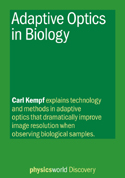
Carl Kempf’s new short-form Physics World Discovery ebook is free to read
In 1953, however, astronomer Horace Babcock proposed a clever solution, which was to bounce incoming light off a device that can rapidly correct for changes in optical path-length, which flattens the wave-front and so counteracts the effects of aberration. Any remaining wave-front errors are measured after the correction, before a feedback control loop uses the measurement to continuously adjust the corrections applied to the wave-front.
That was the principle behind “adaptive-optics” technology, which has since gone on to become a routine and invaluable part of astronomy. Turns out, however, that the same principles can be used in microscopy too, leading to many applications of adaptive optics in medicine and biology too, as I’ve discovered by commissioning and editing a new short-form Physics World Discovery ebook by Carl Kempf.
Kempf is a senior systems engineer at the California-based firm Iris AO, Inc, which is heavily into adaptive-optics technology, having worked on sensing, actuation, and control systems for high-precision devices for more than 30 years. I’m pleased to say that Kempf’s short ebook, Adaptive Optics in Biology, is now available for you to read free in EPUB, Kindle and PDF format via this link.
To give you some more idea of what the book is about and his career to date, I put some questions to Kempf, which you can read below. Don’t forget either that there are plenty of other books in the Physics World Discovery series, ranging from multimessenger astronomy to quantitative finance.
View all posts by this author | View this author's profile
Discover why the philosophy of physics is vital
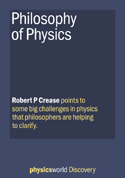
Think about it: Robert P Crease’s new short-form Physics World Discovery ebook is now available to read for free
By Matin Durrani
Avid readers of Physics World will know that we have for many years published a monthly column called “Critical Point” written by Robert P Crease, a historian and philosopher of science from Stony Brook University in New York, in which he examines the interface between physics and the wider culture.
I’ve always felt Crease’s work is interesting but I’m aware that many physicists scoff at the notion of philosophers trying to understand how science works. It’s a waste of time, right?
Following a meal at a vegetarian restaurant round the corner from his apartment in Manhattan earlier this year, I managed to persuade Crease to write one of our new, short-form ebooks that go under the the Physics World Discovery banner. My challenge was for him to explain to physicists just what it is philosophers of physics do – and why their work is important.
You can read Crease’s book Philosophy of Physics, which has just been published, for free in either epub, Kindle or PDF formats via this link. To whet your appetite, Crease has answered some questions about his approach to philosophy and why the book is worth reading. Don’t forget there are plenty of other books in the Physics World Discovery series, ranging from multimessenger astronomy to quantitative finance.
View all posts by this author | View this author's profile
Applied physics and Japan’s ageing population
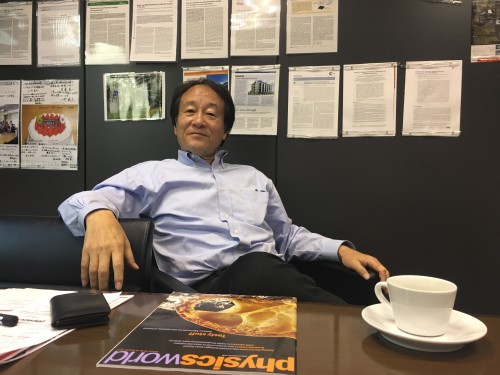
Keeping giong: Satoshi Kawata from Osaka University remains active despite having just officially retired. (Courtesy: Matin Durrani)
By Matin Durrani in Osaka, Japan
By most measures, Japan is one of the wealthiest nations in the world. Depending on which criterion you use, it’s either the third or fourth biggest economy on the planet. Much of that success is built on the country’s prowess in science and technology, which have supported numerous hi-tech giants of the corporate world.
Still, not everything is rosy in the Japanese garden. After the post-war boom years, the economy began to slump in the early 1990s and has picked up only slowly since then. To make matters worse, Japan has also had to contend with rising social-security costs to support an ageing population. Plummeting birth rates and steadily rising death ages mean that Japan’s population has fallen by just over 1% since 2010 to 126 million.
I was thinking about such matters yesterday as I walked through a shopping mall in central Osaka on my way to meet applied physicist Satoshi Kawata from the University of Osaka. Okay, it was a weekday lunchtime and this is just one data point, but there sure were lots of pensioners out shopping. I was also surprised to see a guy selling The Big Issue – the magazine that supports homeless people who want to make a living. I’d not seen any inkling of poverty in the country up to that point.
View all posts by this author | View this author's profile
When will Japan get its next physics Nobel prize?
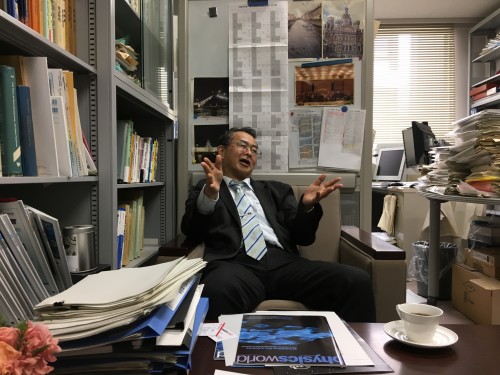
Thirteen and counting: Hikaru Kawamura wonders when Japan will get its next Nobel Prize for Physics.
By Matin Durrani in Osaka, Japan
Hikaru Kawamura, president of the Physical Society of Japan (JPS), handed me a brochure as we sat down in his office on the fifth floor of the Department of Earth and Space Science at Osaka University. Inside it were photographs of the 13 Japanese physicists who have won the Nobel Prize for Physics.
It’s an impressive list of people, starting with Hideki Yukawa, who won the 1949 prize for his theory of the nuclear force, and going all the way up to Takaaki Kajita who shared the 2015 prize for detecting atmospheric neutrino oscillations at the Super-Kamiokande underground lab. (They’re all men, of course, but that’s another story.)
However, Kawamura admitted to me during our 90-minute discussion, that he is “not optimistic” that Japan will be as prolific in terms of Nobel prizes in the future. Most Nobel laureates usually (though admittedly not always) win their awards for work done 20-30 years ago. So with Japanese physics these days being, as Kawamura puts it, “not so popular as it used to be”, how long will Japan have to wait for its next physics Nobel prize?
View all posts by this author | View this author's profile
How to get your paper noticed
By Matin Durrani in Tokyo, Japan
For physicists, doing research is only the start of the game. With thousands of papers published each year, how do you make sure your latest work stands out from the crowd?
If you’re an established academic, your peers will already know who you are and, provided you can continue getting your papers published in the top journals, your career will carry on hitting the high notes . But if you’re less experienced in the research game, then a good dose of publicity in the mainstream media can give you a great head start – and thankfully the online world can help hugely.
That was the message of a seminar “Science communication in the digital age” given today at Tokyo Institute of Technology by me and my IOP Publishing colleagues Michael Banks (Physics World news editor) and Elaine Tham (associate director for Asia-Pacific). Attended by about 40 students, science communicators and university administrators, the seminar was opened by the president of Tokyo Tech Yoshinao Mishima.
View all posts by this author | View this author's profile
RIKEN celebrates its centenary

Cool stuff: these liquid-helium tanks are used to chill the superconducting magnets at RIKEN’s accelerators in its Radioactive Ion Beam Facility. (Courtesy: Matin Durrani)
By Matin Durrani in Wako, Japan
It’s funny where chance encounters can lead.
Earlier this year, I was at a reception for science journalists at the Fenway Park baseball stadium in Boston, US, when I bumped into Jens Wilkinson, who works in the communications team at RIKEN – one of Japan’s biggest research institutions. He encouraged me to visit the lab, which was founded 100 years ago, should I ever find myself in Japan.
And so here I was at RIKEN’s headquarters in Wako, just north of Tokyo, on day two of my trip to gather material for the upcoming Physics World special report on Japan. Wako is home to the largest of RIKEN’s seven campuses, which together employ almost 2000 researchers.
Apart from celebrating its centenary this year, which included an event in downtown Tokyo with none other than Emperor Akihito, RIKEN has been in the news for its discovery of element 113. Created at the RIKEN Nishina Center for Accelerator-Based Sciemce by smashing zinc nuclei into a bismuth target, the element was last year officially named “nihonium” (Nh).
View all posts by this author | View this author's profile
